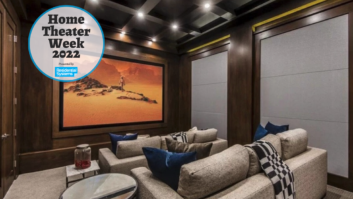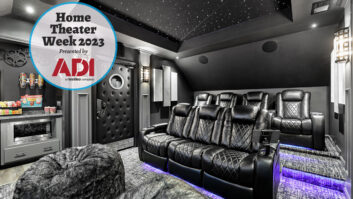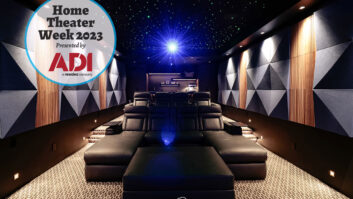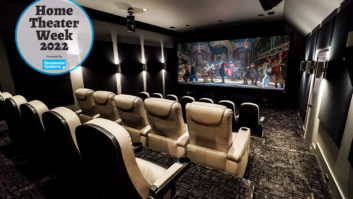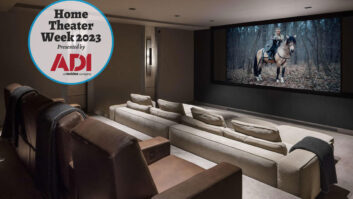Continuing a trend from last year, the widespread adoption of DVI/HDCP (Digital Visual Interface with High-bandwidth Digital Content Protection) on DTVs and high-definition set-top boxes will continue throughout 2003. With the support of the major motion picture studios, this interface is a key enabler for the release of high-quality, uncompressed digital HD content for the best in both content and image quality.
Now a new specification, called HDMI, is building on the features and benefits of DVI, adding new capabilities designed specifically for the consumer electronics market while maintaining full backward compatibility with DVI. With prototype products on display at CES, HDMI has been positioned as the next-generation digital interface for consumer electronics, by combining high-definition video and multi-channel audio in a single connector.
From DVI to HDMI – What Does It Mean? What Do I Need? While consumer electronics devices themselves have gone digital, the audio and video interfaces connecting them have remained analog. The concept of a digital video interface is not new to computer displays. In 1999, the DVI specification was released. It quickly became the standard digital interface between a PC and a digital display, and is now found on many LCD monitors and most plasma panels and projectors. The DVI link provided a low-cost, high-bandwidth solution, enabling an all-digital video link for high-resolution displays up to UXGA (1600 x 1200 lines) and beyond. A year later, Intel introduced HDCP with contributions from semiconductor provider Silicon Image. HDCP protects content on a digital link by adding encryption capability.
Next, major motion picture providers became interested in DVI with HDCP, as it provided a means of protecting their high-value content between a digital source device (such as a set-top box or DVD player) and a DTV. Satellite and cable service providers, seeking a larger library of high-quality HD content for their customers, quickly supported DVI as an output on their set-top boxes. DTV manufacturers responded in kind by incorporating DVI-HDCP inputs on their systems.
By the end of 2002, nearly 50 percent of all new DTVs had DVI-HDCP inputs. With the ability to support uncompressed HD content (720p or 1080i) and with the endorsement of content providers, distributors and CE manufacturers, 2003 will mark the overwhelming adoption of DVI as a must-have interface for digital CE devices. Currently, there are more than 140 devices with DVI-HDCP on the market, including 80 HDTVs, 43 projectors, 11 set-top boxes, two DVD players and one A/V receiver.
Building upon the success of DVI, a new digital interface was needed that specifically addressed the unique needs of the consumer electronics market, one that requires the highest quality digital video and audio, a sleek, user-friendly connector, and intelligent communication between various source and display devices. Silicon Image and a number of global consumer electronics companies formed the HDMI working group to address these needs. Hitachi, Matsushita Electric (Panasonic), Philips, Silicon Image, Sony, Thomson and Toshiba worked together to define a next-generation digital interface for consumer electronics products. This effort culminated in the release of the HDMI specification in December 2002.
Elevating the home theater experience to a higher level, HDMI enables an all-digital interconnect from digital consumer electronics source devices and digital displays for crystal-clear audio and video and an enhanced user experience. As an end result, HDMI offers a home theater experience with the following benefits:
*Content: HDCP security is available for HDMI products, enabling the release of premium HD digital content. One way to ensure that HDCP is present is to look for HDMI products featuring the PanelLink Cinema Partners logo, which assures consumers of access to premium HD content. Major motion picture providers Fox and Warner Bros., consumer electronics manufacturers JVC, LG/Zenith and Sharp, and cable/connector manufacturer JAE have already endorsed PanelLink Cinema Partners.
*Convenience: HDMI is the first all-digital consumer electronics interface that can support every uncompressed standard-, enhanced- and high-definition video format, including 720p and 1080i, as well as all existing multi-channel audio formats on a single cable. A small CE-friendly connector is defined in the HDMI specification, replacing the bulkier DVI connector.
Unlike earlier video and audio interface solutions that provided better performance while at the same time increasing cabling complexity, HDMI actually simplifies home theater wiring. HDMI only requires a single cable to connect each digital home theater component, significantly reducing the number of cables needed to install a home entertainment system. One HDMI cable can replace up to 11 audio and video cables, significantly reducing the clutter behind the typical home entertainment system, potentially reducing overall system costs for consumers without sacrificing video and audio quality.
*Digital quality: HDMI enables an all-digital link between the digital content from a set-top box, DVD player, A/V receiver or D-VHS player and the digital television. With the increasing shift to digital display technologies such as LCD, plasma and DLP, the digital content is not converted into analog format and therefore does not bear the associated losses. HDMI carries uncompressed digital video.
*Intelligence on the link: HDMI supports bi-directional communication between devices. This means the DTV can communicate its preferred video and audio formats (e.g. wide-screen 16:9 format and two-channel stereo) to the set-top box and the set-top box can communicate what video format it is providing (e.g. 16:9 letterbox in a 4:3 frame) to the display device. This bi-directional communication enables the DTV to make intelligent decisions on how to best render the image (eg. scale the letterbox content to fill the screen.)
*Simple control over HDMI devices: Because of its digital nature, HDMI enables the consumer to use a single remote control for all HDMI devices. An embedded CE control bus will send instructions (such as “pause” or “fast-forward”) to the HDMI devices, simplifying ease of use.
In an effort to ensure that all HDMI devices and cables meet the HDMI specification, compliance testing will be an integral part of the HDMI program. As HDMI is a new interface, there are a number of issues that installers should understand and know about, including:
*Compatibility: HDMI is fully backward compatible with DVI. An HDMI device, when plugged into a DVI device using a DVI-HDMI interchange cable, will support digital video over the link. DVI splitters and repeaters are available from multiple third parties supporting more complex home installations and HDMI splitters and repeaters should be available later this year.
*Cable length: Silicon Image has demonstrated HDMI over 20m cable lengths, and we anticipate a range of cables to be readily available. Silicon Image’s TMDS technology-the foundation of the DVI and HDMI specifications-is DC-balanced, allowing fiber-optic solutions for very long cable support. DVI fiber-optic extension cables up to 500m are available and are typically used for projectors in conference rooms and auditoriums.
*Supported video formats: All existing NTSC, PAL and ATSC formats, ranging from 480i to 720p and 1080i. HDMI also has the bandwidth to support 1080p video.
*Supported audio formats: Compressed formats such as Dolby Digital, Dolby Digital EX, DTS, DTS EX and uncompressed formats (PCM audio) up to 8 channels, up to 192kHz, up to 24 bits.
It is worth noting that HDMI is not a home networking solution. It has been developed to support uncompressed video and audio as a point-to-point solution (for example, from the DVD player to the A/V receiver, and the A/V receiver to the DTV.) HDMI is not an input to recording devices. HDMI is, however, a home theater solution for the future. With more than enough bandwidth, new requirements and capabilities can be easily added in the future, and we expect HDMI connectors will still be found on new CE devices 50 years from now.
Developments at CES. The first HDMI prototypes were demonstrated at CES in January, including digital projection TVs from Panasonic; Samsung’s DirecTV set-top box and 63-inch plasma display; JVC’s 48-inch digital rear projection TV; and Meridian’s high-end DVD player derived from the 800 Series. All of these prototypes featured Silicon Image’s new PanelLink Cinema chipset, offering HDMI with HDCP for an HD content-ready solution. Silicon Image previously developed similar ICs for the DVI/HDCP interface, and to date has sold more than 30 million DVI chips for the PC/Display and consumer electronics markets.
Silicon Image also announced the creation of PanelLink Cinema Partners, a multi-industry initiative designed to give consumers the confidence to buy HD content-ready products equipped with HDMI and HDCP. PanelLink Cinema Partners brings together companies from the consumer electronics, semiconductor and motion picture industries to accelerate the adoption of HDMI with HDCP while ensuring certain product and cable compliance and interoperability specifications are met. Participating companies are committed to providing products that incorporate or support HDMI and HDCP, thus enabling consumers to receive and render premium, high-definition digital video content.
John LeMoncheck, is vice president of Consumer Electronics Products at Silicon Image in Sunnyvale, California.
